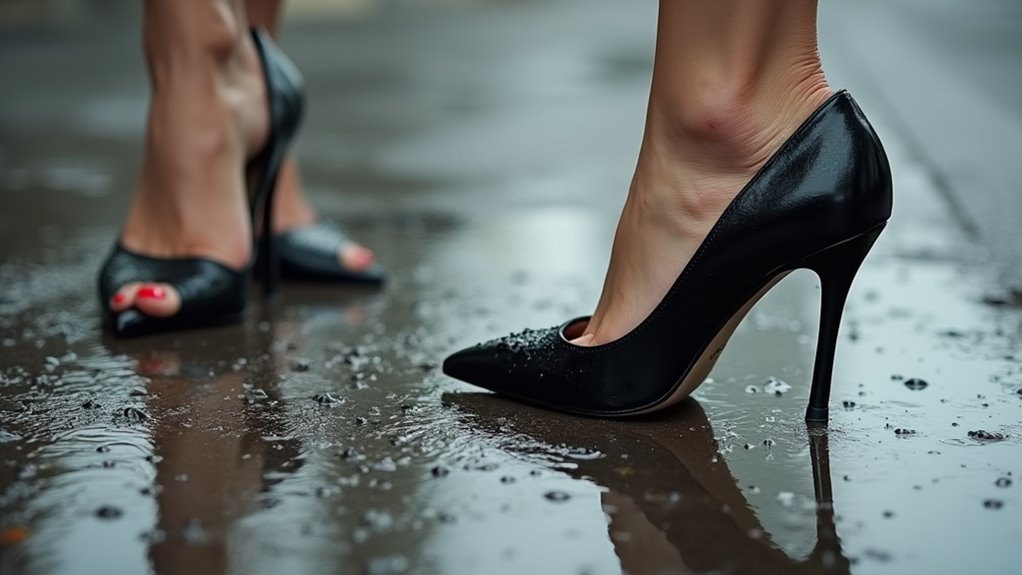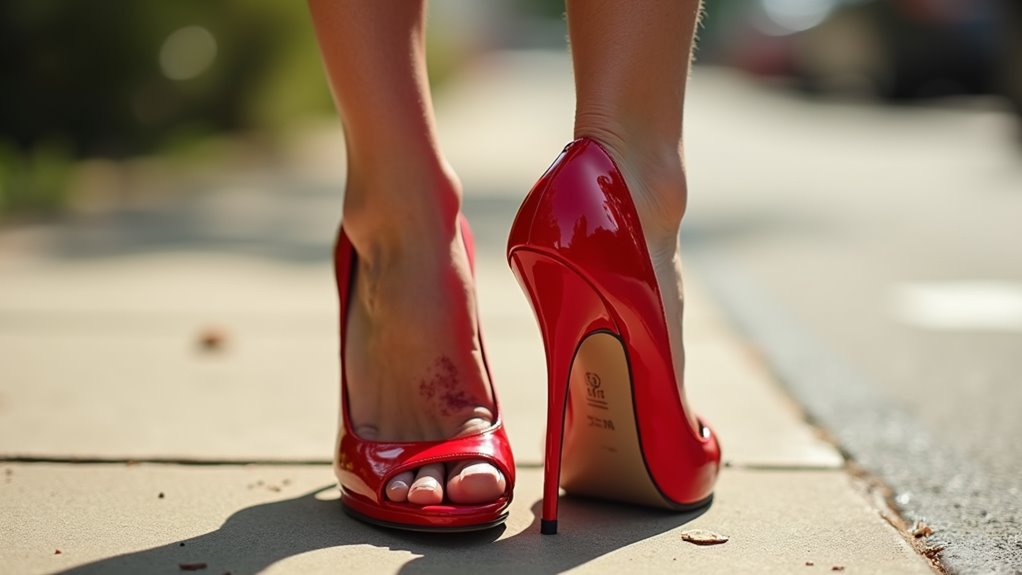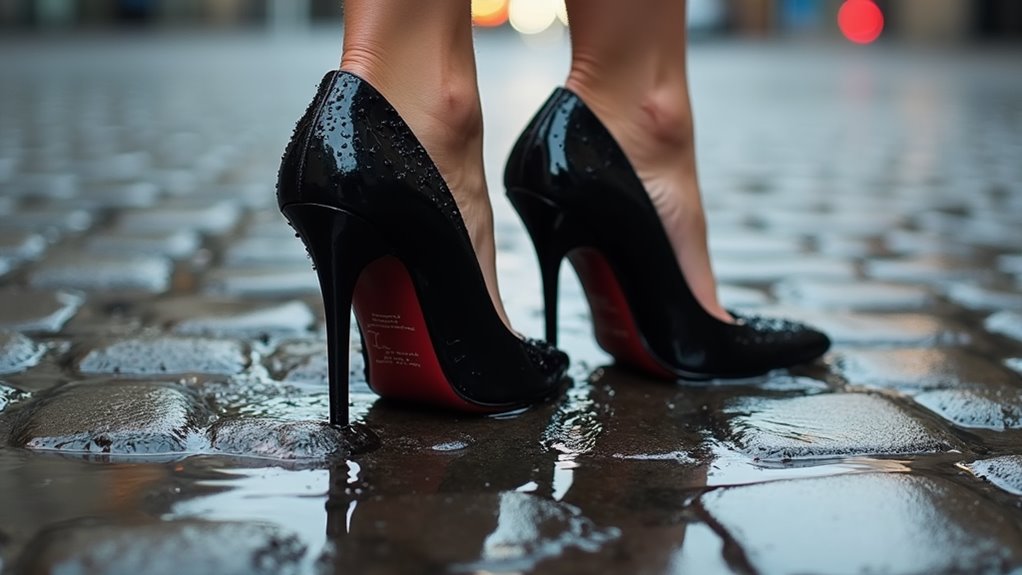There may be products. Products are independently selected by our editors. We may earn an affiliate commission from the links with no charge to you, example: as Amazon Affiliate.
If you’ve ever felt like your high heels are secretly plotting against you when the weather changes, you’re not imagining things. Your feet’s relationship with the elements can turn your favorite stilettos from fabulous to frustrating in an instant. Weather conditions don’t just affect your hair and mood – they’re actively influencing how your feet feel and function in those heels you love. From winter’s bite that leaves your toes numb to summer’s sweltering heat that makes your shoes feel two sizes too small, understanding these seasonal challenges can help you protect your feet while maintaining your style.
Key Takeaways
- Cold weather reduces blood circulation to feet, making high heel wear more uncomfortable and increasing joint pain.
- Hot weather causes foot swelling (heat edema), leading to tighter fit and increased pressure in high heels.
- Wet conditions increase fall risks in high heels, especially with stilettos, making block heels or wedges safer options.
- Humidity raises fungal infection risks, requiring extra attention to foot hygiene when wearing enclosed high heels.
- Seasonal temperature changes affect leather and material flexibility, impacting heel comfort and requiring appropriate moisture management.
Weather and Foot Health Basics

While many people focus on how weather affects their mood or plans, its impact on foot health is equally significant.
Weather conditions directly influence your joints by altering synovial fluid, which can trigger inflammation and discomfort in your feet, especially when wearing high heels.
When temperatures drop, you’ll notice reduced blood flow to your extremities as blood vessels constrict, potentially intensifying foot pain.
The seasonal transitions between warm and cold weather can be particularly challenging, often leading to dry, cracked skin.
You’ll need to pay extra attention to foot hygiene during humid conditions to prevent fungal and bacterial infections.
Understanding these weather-related effects on your feet is crucial, as they’ll influence how comfortable you feel in heels throughout different seasons.
High Heels During Winter Months
Despite their fashionable appeal, high heels pose significant risks during winter months. When you combine slippery surfaces with elevated footwear, you’re increasing your risk of falls and injuries.
Cold temperatures also affect your feet’s circulation, especially when wearing heels that already restrict blood flow.
To protect your feet while wearing heels in winter, consider these essential steps:
- Choose block heels or wedges with slip-resistant soles for better stability
- Select water-resistant materials and closed-toe designs to keep feet dry
- Opt for styles with ankle support to prevent slips on icy surfaces
Don’t forget that winter’s low humidity can make your feet more susceptible to dryness and cracking.
If you have conditions like diabetes or neuropathy, you’ll need to be extra cautious when wearing heels in cold weather.
For maximum comfort during extended wear, look for heels with cushioned formal soles that provide extra padding and support.
Summer Heat Impact

Nearly every high heel wearer faces unique challenges during summer months when temperatures soar. Your feet will swell more than usual due to heat edema, making those stylish pumps feel uncomfortably tight. The combination of heat and high heels can seriously impact your comfort and foot health.
| Issue | Cause | Solution |
|---|---|---|
| Swelling | Blood vessel dilation | Elevate feet above heart |
| Moisture | Heat-induced sweating | Use breathable footwear |
| Pain | Increased pressure | Choose lower heels |
You’ll want to take extra precautions when wearing heels in summer heat. Consider wearing compression stockings to prevent fluid buildup, and give your feet regular breaks with elevation. Don’t forget to apply foot powder to combat moisture and prevent fungal infections that thrive in warm, damp conditions. Finding the right comfort solutions online can help you maintain healthy feet during hot summer days.
Seasonal Foot Care Tips
Properly caring for your feet as seasons change can make a significant difference in your comfort while wearing high heels. As winter approaches, you’ll need moisture-wicking socks and rich moisturizers to prevent dry, cracked heels.
During spring, focus on breathable footwear and proper ventilation to avoid bacterial growth.
Consider switching to eco-friendly non-leather heels for a sustainable and comfortable footwear alternative that’s gentle on the environment.
To maintain optimal foot health year-round while wearing heels:
- Moisturize your feet twice daily, focusing on heels and soles, but avoid applying lotion between toes where friction can lead to infections.
- Select weather-appropriate shoes that provide adequate room for toes and proper arch support.
- Keep feet dry and clean, checking regularly for signs of irritation or discomfort.
Remember to break in new heels gradually and take frequent breaks during extended wear to prevent fatigue and potential injury.
Weather-Related Pain Management

When dealing with weather-related foot pain in high heels, you’ll need different strategies for both cold and hot conditions.
During cold weather, you can reduce joint stiffness and discomfort by wearing insulated footwear when possible and switching to lower heels with wider toe boxes.
In hot weather, you’ll want to manage swelling by choosing breathable materials, using moisture-wicking insoles, and taking regular breaks to elevate your feet.
For optimal comfort year-round, consider installing Smart Comfort Technology in your home to maintain ideal temperature and humidity levels for your feet.
Managing Cold Weather Pain
Although cold weather can intensify foot pain for high heel wearers, several effective management strategies can help you stay comfortable during chilly months.
When you’re dealing with cold-induced foot discomfort, focus on maintaining proper circulation and providing adequate support for your feet.
Here are three essential steps to manage cold weather foot pain while wearing heels:
- Switch to supportive, well-insulated footwear with slip-resistant soles when outdoors, saving your heels for indoor events.
- Keep your feet warm with wool socks and consider using heated insoles for additional comfort.
- Improve circulation through light exercises and warm foot soaks, especially after wearing heels.
Don’t forget to consult a podiatrist if you experience persistent discomfort, as cold weather can exacerbate existing foot conditions.
Hot Weather Relief Tips
Soaring temperatures can make wearing high heels particularly challenging during hot weather months. You’ll need to take extra precautions to protect your feet from discomfort and potential injury. Choose breathable materials like mesh or leather, and apply sunscreen to exposed areas of your feet to prevent sunburn.
| Prevention | Comfort | Relief |
|---|---|---|
| Use moisture-wicking socks | Select lower platforms | Apply cooling sprays |
| Apply foot powder | Take regular breaks | Elevate feet |
| Wear breathable shoes | Use quality insoles | Stay hydrated |
| Keep feet clean | Alternate footwear | Use gel cushions |
To minimize discomfort, treat high heels like dessert – wear them sparingly. When you do wear them, start with lower heights and gradually work your way up. Keep foot care essentials handy, and remember to give your feet breaks throughout the day.
Choosing Weather-Appropriate Heel Styles
Your heel height should match the weather conditions, with lower heels providing better stability during wet or icy conditions.
You’ll want to select materials like water-resistant leather or suede that can withstand seasonal elements while keeping your feet warm and dry.
Make each step count by choosing heels with slip-resistant soles and good traction that protect you from weather-related hazards.
Consider eco-friendly shoe options made from sustainable materials that perform well in various weather conditions while minimizing environmental impact.
Heel Height for Weather
When selecting heels for different weather conditions, three key factors come into play: height, stability, and style. You’ll want to adjust your heel height based on the weather to ensure safety and comfort. For icy or wet conditions, opt for lower heels with wider bases to maintain better balance and reduce slip risks.
When choosing weather-appropriate heel heights, consider these essential guidelines:
- Keep heels under 2 inches for snowy or icy conditions, focusing on block heels or wedges for enhanced stability.
- Choose boots with ankle support and closed-toe designs to protect your feet from cold and moisture.
- Select heels with slip-resistant soles and gripping materials to prevent accidents on wet or slippery surfaces.
Remember to prioritize weather-appropriate styles that offer both functionality and fashion, such as ankle boots or knee-high options during colder months.
Seasonal Material Selection
The right materials for your high heels can make a significant difference in comfort and durability throughout the changing seasons.
In winter, opt for leather or suede heels, as they’ll provide essential warmth and insulation. These materials are naturally durable and protect your feet from cold, wet conditions.
For spring and summer, you’ll want to switch to breathable, lightweight materials like mesh or fabric. These options help prevent excess sweating and reduce the risk of bacterial growth.
Look for styles with moisture-wicking properties and good arch support for increased warm-weather activity.
During autumn’s transitional weather, choose flexible materials like nubuck or weather-resistant suede.
These versatile options work well with socks or tights and offer the adaptability you need for unpredictable temperatures.
Weatherproof Your Steps
Selecting weather-appropriate heel styles can make all the difference between a comfortable stride and a painful trek through challenging conditions. When facing wet weather, opt for heeled boots with rubber soles and water-resistant properties to keep your feet dry and stable.
For cold conditions, chunky heels and insulated knee-high boots provide warmth while maintaining style.
To maximize comfort and protection in any weather:
- Choose block heels or platforms for optimal stability on slippery surfaces
- Ensure proper fit with room for weather-appropriate socks and potential foot swelling
- Select boots with quality zippers and elastic fittings to prevent moisture from seeping in
Remember to prioritize shoes with adequate traction and insulation based on the conditions you’ll encounter, and don’t forget to consider your specific foot needs and activity level.
Preventive Measures for Foot Protection

To protect your feet while wearing high heels in various weather conditions, you’ll need more than just the right pair of shoes. Start by selecting footwear with proper fit and adequate cushioning, including silicone metatarsal pads for shock absorption.
Adapt your foot care routine to the seasons. In winter, keep feet moisturized and wear insulated shoes. During summer, choose breathable footwear to prevent moisture buildup. Don’t forget to apply sunscreen to exposed areas of your feet.
For specific events, use heel protectors when walking on grass or grates. Consider open-toe styles if you’re prone to corns or calluses. Pay attention to the heel’s pitch and regularly check your shoes’ fit.
Add specialized insoles for targeted support, and remember to massage and stretch your feet to maintain comfort throughout the day.
Long-Term Effects and Solutions
While fashionable and stylish, prolonged high heel use can lead to severe foot problems that affect your daily comfort and mobility.
Your feet endure significant structural changes, including shortened Achilles tendons and distorted weight distribution, which can result in chronic conditions like arthritis and persistent joint pain.
To protect your feet while wearing heels, consider these essential solutions:
- Alternate between high heels and supportive flat shoes daily to prevent tendon shortening
- Choose thicker heels over stilettos to distribute weight more evenly
- Use orthotic inserts or metatarsal pads to cushion impact
You’ll also want to maintain proper foot care throughout the seasons.
In winter, focus on moisturizing; during summer, opt for breathable footwear; and in spring and fall, ensure your shoes fit correctly to prevent blisters and bunions.
For optimal foot health and comfort, consult foot doctor approved products designed specifically for high heel wearers.
Conclusion
Let’s face it – you’re not giving up your stilettos just because Mother Nature’s throwing a tantrum. While you’ve learned how weather wreaks havoc on your feet in heels, you’ll probably still strut through snowstorms and heatwaves alike. At least now you’re armed with knowledge to protect those precious feet – even if you’re too stubborn to wear sensible shoes when the weather turns wild.

